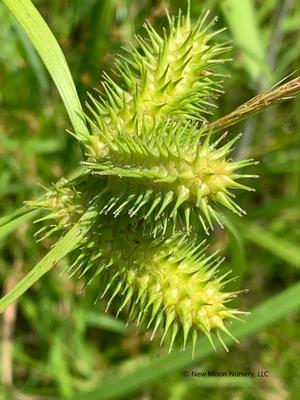Printed at http://www.newmoonnursery.com/index.cfm/
Carex lurida
Lurid sedge
Native to North America
FIRST IMPRESSIONS: Carex lurida is a large tufted wetland sedge. The narrow leaves are a bright yellow green and about 1’ long. In late spring stiff triangular culms rise above the foliage to 3’ bearing chartreuse bottlebrush shaped spikes. Attractive warm brown seed spikes follow. This bold sedge flourishes in sun or part sun in damp or wet sites. Plants prosper in difficult wet mucky soils and tolerate seasonal flooding.
HABITAT & HARDINESS: Carex lurida is native to the southern Canadian provinces from Ontario to Newfoundland and Labrador. Plants occur in the United States from Minnesota to Maine and south from the Florida panhandle to east Texas. The greatest distribution is in states bordering the Atlantic Ocean from New England down to South Carolina.
Plants are indigenous to sedge meadows, swamps, margins of marshes, seeps, pond and lake margins, wet meadows and ditches.
Hardy from USDA Zones 2-9.
PLANT DESCRIPTION: Carex lurida is a graceful clump forming sedge with a fountain like habit.
The arching leaves are about 12” long with a distinct channel that runs the length of the blade.
In late spring sharply angular leafy culms rise above the basal foliage. The fertile culms produce a terminal staminate spikelet and several oblong pistillate spikelets, The pistillate spikelets are yellowish and bristly because of long perigynia beaks.
Mature spikelets are attractive and light brown.
This sedge is 2.5’ tall with an equal spread.
CULTURAL & MAINTENANCE NEEDS: Carex lurida thrives in sunny moist or wet sites and tolerate seasonal flooding. It is essential that planting sites remain moist.
Plants are pest resistant and unpalatable to deer and other herbivores.
LANDSCAPE USES: Carex lurida is valuable for Wetland Restoration and soil retention in Bioswales and drainage ditches. This sedge is useful in Wet Meadows and is a good component for a Grouping or Mass Planting. Plants provide Erosion Control and Attractive Seedheads and are appropriate for Deer Resistant Plantings, Low Maintenance Plantings, Rain Gardens and Wildlife Gardens.
COMPANION & UNDERSTUDY PLANTS: Try pairing plants with Asclepias incarnata, Lobelia cardinalis, Iris versicolor, Iris virginica and Juncus effusus.
Carex crinita is similar in appearance and cultural needs and can be substituted if needed.
TRIVIA: Carex lurida and other wetland sedges host caterpillars of Eyed Brown Butterflies and several species of Skippers and moths. Many wetland birds feed on the seed. The Sedge Wren feeds and nests in sites dominated by wetland sedges.
This sedge has numerous common names. It is sometimes called lurid sedge due to the shockingly unexpected yellow color of the foliage and seed spikes. Some references call it sallow sedge again due to its yellowish “complexion”. Others call it shallow sedge perhaps in error or perhaps due to its ability to grow in shallow water.
The most distinctive characteristic of Carex lurida is the yellowish color of its pistillate spikelets Carex comosa and Carex hystericina are similar species but both have green pistillate spikes. Compared to Carex lurida, the two look-alikes also have smaller perigynia, and pistillate spikelets that are distinctly nodding.
Height:
3 ftSpread:
1-2 ftUSDA Hardiness Zone:
2-9Bloom Color:
Green, TanCarex lurida Characteristics
Attributes
- Dried Flower
Exposure
- Partial Shade to Full Sun
Deer Resistant
- Deer Resistant
Flowering Months
- June
Grass Season
- Cool Season Grass
Soil Moisture Preference
- Wet to Moist
Interesting Notes:
For more information on this plant, visit the USDA PLANTS Database:http://plants.usda.gov/java/profile?symbol=CALU5

